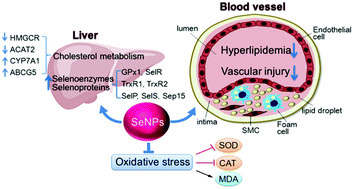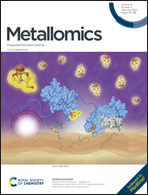Selenium nanoparticles alleviate hyperlipidemia and vascular injury in ApoE-deficient mice by regulating cholesterol metabolism and reducing oxidative stress†
Abstract
Atherosclerosis and related cardiovascular diseases represent the greatest threats to human health worldwide. This study was designed to investigate the anti-atherosclerotic activity of selenium nanoparticles (SeNPs) in apolipoprotein E deficient (ApoE−/−) mice fed a high-cholesterol, high-fat diet. The results demonstrated that animals either treated with SeNPs (50 μg Se per kg per day) or with atorvastatin (10 mg per kg per day) alone showed significant relief of vascular injury after 8 weeks of treatment. SeNPs could obviously decrease the level of serum total cholesterol, triglyceride and low-density lipoprotein cholesterol, whereas increase serum high-density lipoprotein cholesterol. At the same time, SeNPs regulated the expression levels of key genes associated with cholesterol metabolism in the liver. Furthermore, SeNPs significantly reduced the lipid peroxidation level, but increased the NO level and the activities of glutathione peroxidase (GPx), superoxide dismutase (SOD) and catalase in the serum and liver. SeNPs also increased the expression levels of antioxidant selenoenzymes or selenoproteins in the liver. In addition, SeNPs could alleviate H2O2-induced cytotoxicity and oxidative stress by upregulating the activities of SOD and GPx in endothelial cells cultured in vitro. These results suggested that SeNPs could significantly alleviate hyperlipidemia and vascular injury in ApoE−/− mice, possibly by regulating cholesterol metabolism and reducing oxidative stress through antioxidant selenoenzymes/selenoproteins. SeNPs might be a potential candidate for the prevention of atherosclerosis.



 Please wait while we load your content...
Please wait while we load your content...